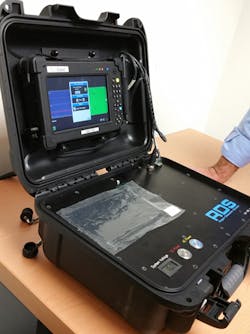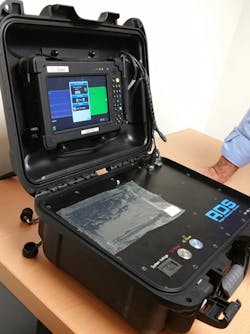Sensor-Based System Detects Hidden Bombs and Weapons
So-called “suicide bombers,” carrying or wearing hidden explosives or weapons as part of terrorist activities, have too often thwarted the best intentions of military and police forces to stop them. Fortunately, a weapon for battling such terrorist efforts has been developed by HSS Development: the latest upgrade of its RDS500 bomb-detection systems, the remote RDS500 Suicide Bomb Detector. This remote-controllable system can detect hidden “walk-by” bombs and weapons.
The sensor-based RDS500 system (see photo) is an effective tool for police, explosive ordnance disposal (EOD) teams, and counterterrorism units that must deal with attacks by terrorists or covert operatives. It can safely scan individuals within range for hidden body-warn explosives, covert weapons, or even embedded shrapnel.
The system employs various sensor technologies to detect metal objects worn under clothing or in backpacks, such as improvised explosive devices (IEDs). The RDS500 system can be covertly placed and controlled via its graphical user interface (GUI) on a remote PC by means of wired or wireless communications link, minimizing operator risk to threats from scanned individuals.
The RDS500 system can be contained in discrete enclosures—or even built into drywall or wall board in buildings—for ultimate concealment. It operates with ac power or a dc supply from a battery. The sensitivity can be user-adjusted to set the performance level as needed for a particular operating environment and application.
The RDS500 is the latest version of a system with well-established sensor technology that provides the performance and reliability to combat terrorist activities involving hidden bombs and weapons. The firm also supplies systems for detection of cellular radio signals and programmable bomb jammers, covering a total frequency range of 20 MHz to 6 GHz with different modules.
About the Author
Jack Browne
Technical Contributor
Jack Browne, Technical Contributor, has worked in technical publishing for over 30 years. He managed the content and production of three technical journals while at the American Institute of Physics, including Medical Physics and the Journal of Vacuum Science & Technology. He has been a Publisher and Editor for Penton Media, started the firm’s Wireless Symposium & Exhibition trade show in 1993, and currently serves as Technical Contributor for that company's Microwaves & RF magazine. Browne, who holds a BS in Mathematics from City College of New York and BA degrees in English and Philosophy from Fordham University, is a member of the IEEE.

